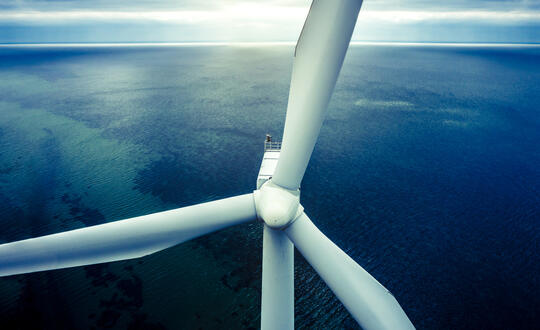
The UK has set ambitious targets of reaching 50GW of offshore wind capacity by 2030 while it maintains a high level of environmental protection. The Energy Act (Act) helps to achieve this target by integrating in its Part 13 provisions on the Offshore Wind Environmental Improvement Package (OWEIP). This Part of the Act is intended to empower the Government to halve consenting times for offshore wind projects through customised habitats regulations assessments (HRA) and through the delivery of compensatory measures at a strategic level when offshore wind activities have an adverse impact on marine protected areas. Let's delve into the details of Part 13 of the Act.
Which offshore wind activities fall under the Act?
The Act defines offshore wind activities falling under the scope of Part 13 broadly to capture the full lifecycle – planning- construction-operation-decommissioning- of an offshore wind farm, and covers generating and transmission assets. The latter also include multipurpose interconnectors. The Act does not make any reference to the repurposing or repowering of offshore wind assets, but this is expected to be included. Plans for the development of offshore wind projects, for example leasing rounds organised by the Crown Estate, also count as relevant activities. This is important given that future leasing rounds may identify HRA impacts and the consequential need to deliver compensation.
What are strategic compensatory measures?
Strategic compensatory measures (SCMs) are a collaborative mechanism that developers of offshore wind activities can use to compensate for adverse effects on the integrity of protected sites. SCMs are a last resort: they apply when all other feasible options to avoid, reduce or mitigate the adverse effects are exhausted.
The Act empowers public authorities, required to secure compensation, to determine that measures taken at a strategic level can count towards discharging that public authority's duties. The authorities can take a "mix and match" approach to the delivery of compensatory measures by:
- Creating a "bank" of measures already taken and combine them with measures that will be delivered in the future
- Delivering measures onsite and offsite
- Alowing measures taken by one authority (i.e. Scottish Ministers), with their consent, to be counted towards discharging the duties of another authority (i.e. Secretary of State for Energy, Security and Net Zero).
What is the Marine Recovery Fund?
In practice, SCMs will be delivered through the Marine Recovery Fund (MRF). Developers will pay into the fund and the contributions will be used to cover the cost of providing strategic compensation. More than one fund can be established. Different funds could align to different jurisdictions, i.e. England, Wales and Scotland. The devil will be in the detail, as regulations yet to be drafted will determine the establishment, operation and management of the MRF and will also confirm whether payment into the fund can act to discharge consent conditions on a developer to deliver effective compensatory measures.
How do tailored HRAs for offshore wind activities work?
Compensatory measures are only required if a HRA determines that there would be an adverse effect on the integrity of a marine protected area. However, there can be disagreement on whether an adverse effect would occur or, if it would, on the magnitude of the effect for which compensation is required. Provided it does not undermine the protection currently afforded through HRA to marine protected areas, the Act gives powers to require a more focused and up-front HRA process to address some of these issues head-on. Again, the detail will be in regulations yet to be seen which will be subject to consultation, including with Statutory Nature Conservation Bodies (SNCBs).
Are SCMs and Marine Net Gain connected?
The Government is looking into introducing of Marine Net Gain (MNG) i.e. measures that will improve the status of the marine environment. When relevant provisions on MNG are adopted in the future, these are likely to be distinct from SCMs. MNG would aim to achieve an improved state of the marine environment in the course of implementing a project. SCMs serve a different purpose of restoring rather than enhancing the marine environment. .However, in its recent response to the MNG consultation, the Government seems keen to use MRFs to deliver MNG in case the latter is assessed on a contribution-based approach.
What happens next?
Compensatory measures have now been required for a number of offshore wind farms but the ability to deliver those measures and their effectiveness is only just starting to be tested. Some developers are working together to deliver a single set of measures which could compensate for multiple projects, but the Act provides clear recognition of the need for a Government led strategic solution if offshore wind targets are to be met. Setting up offshore wind compensation funds like the MRF is an emerging trend, with some States in the US considering similar options.
However, it has taken some time to get even this far. The OWEIP measures enter into force later this year. But for the provisions to be practically applicable, the Government needs to work hard to put in place new or amend existing secondary legislation. This might prove even more difficult for projects in Wales, since the Welsh Parliament withheld its consent on offshore wind provisions in the making of the Energy Act. There were hopes that the MRF would be open in 2023, but regulations have yet to be drafted and there seems to be little prospect that the MRF will become a reality any time soon. In the meantime, developers will need to continue to work up their own compensatory measures which can be delivered independently, or collaboratively with other developers, in order to secure their consents.
Our team of lawyers is here to discuss more on the OWEIP chapter of the Energy Act. Get in touch.





